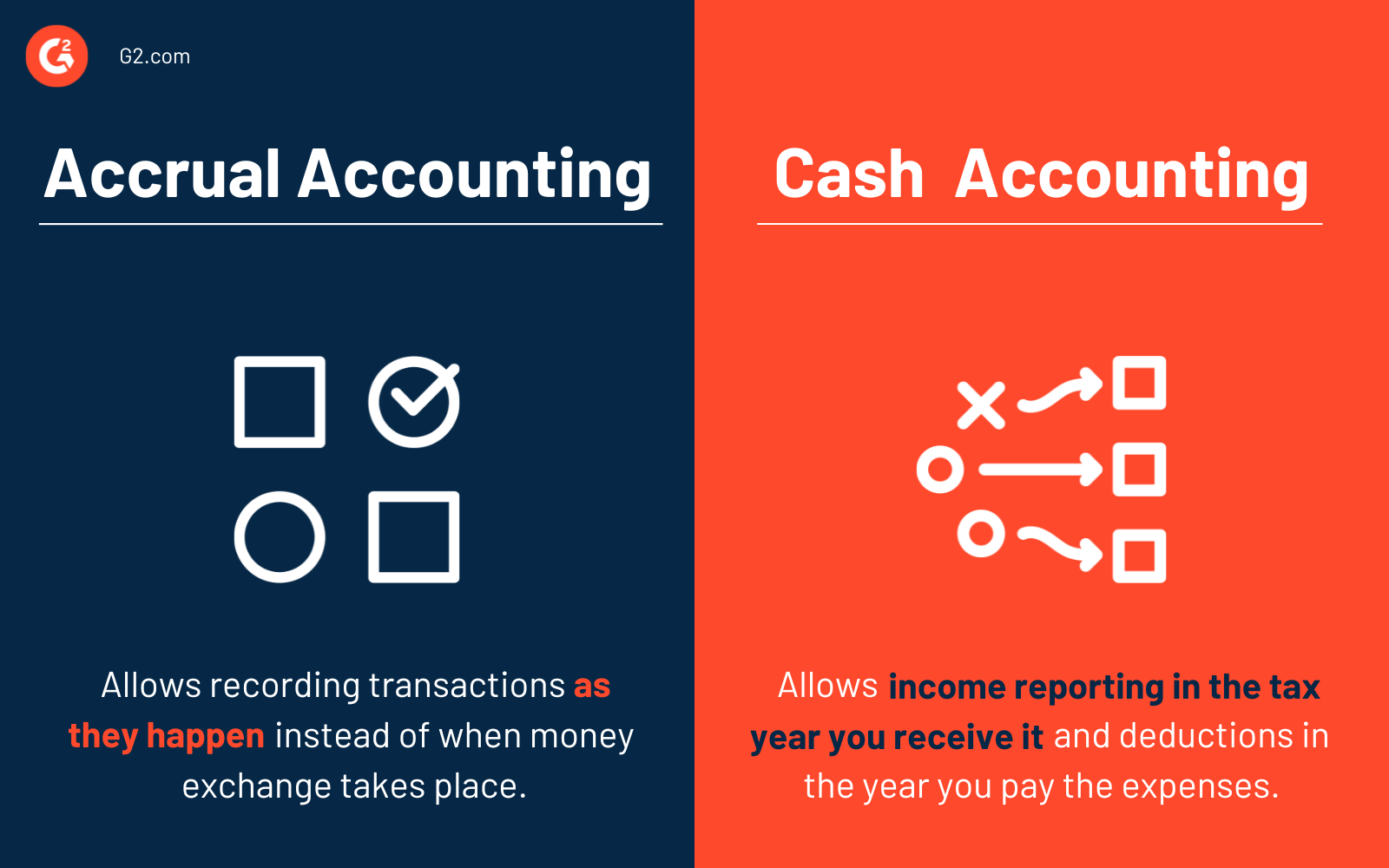In 1916, a new form of accounting revolutionized the way we work.
With the introduction of accrual basis accounting, cash was no longer necessary for a business to declare its revenues. A precursor to credit cards, it established a system of accrual accounting.
Accrual basis accounting is a bookkeeping method that companies use to record revenue and match expenses as they are generated instead of when the money changes hands. The accrual method lets companies recognize expenses while incurring the liability instead of at the time of payment.
Cash is still king for millions of people, and there’s nothing wrong with running your small business on traditional cash-based accounting. With a little help from accounting software, managing your books and following your paper trail with the cash method is quick and painless.
But understanding accrual accounting is a smart play, no matter how you slice it, especially if you plan on growing. No pressure, though: We love your company just the way it is.
What is accrual basis of accounting?
Accrual basis of accounting is a financial method of accounting that lets a company record revenue when earned and expenses when incurred, regardless of the actual money exchange.
In a way, the accrual accounting method is an honor system. When you are executing hundreds or even thousands of transactions a day — many with belated payment due dates or installments — cash itself is fluid and sometimes elusive. This makes it difficult to operate to your full potential. The accrual basis allows you to make decisions based on the capital you are promised, in addition to the bona fide assets in your accounts.
Accrual method of accounting merges two accounting principles:
- Matching principle states that you should recognize expenses in the same period as the revenue they generate.
- Revenue recognition principle states that you should recognize revenue either at the time of earning or realizing it.
An accrual accounting system offers better insights into profitability by painting an accurate picture of revenue, expenditures, assets, and liabilities on the balance sheet. That’s why the General Accepted Accounting Principles (GAAP) recognizes the accrual method. The Securities and Exchange Commission (SEC) also requires publicly traded companies to follow accrual accounting.
How does accrual basis accounting work?
In an accrual accounting scenario, your varied revenues are logged as “earned” when the sale occurs, regardless of the payment schedule. Transactions without cash in hand are booked into your current assets under the “accounts receivable” section in your balance sheets.
Typically, if these journal entries are paid off in a year or less, they can be considered short-term assets. Anything that is still owed to you is also referred to as a “liability.”
You and your customers enter an agreement that bills will be paid on time. With the appropriate screening and established trust with a contract, this shouldn’t be an issue. But the possibility that money isn’t received, however small, is an assumed risk with this type of accounting.
Regarding your cash flow, you can track money owed for goods, services, and other creditors in the “accounts payable” section of your financial statements.
You may decide on a big purchase and subtract the eventual final cost from your short-term assets in accounts receivable. These purchases add to your overall liabilities, but this allows you to keep your liquid assets safe in the bank and those sections of your balance book unbothered.
In this way, the accrual system is like a revolving door of short-term assets kept separate from your long-term assets. When considering your bottom line, though, you can factor in both amounts.
Types of accrual accounts
Accrual basis accounting uses four types of accounts.
1. Accounts receivable refers to the amount you’ll receive for sales made on credit.
2. Accounts payable is the amount you owe to suppliers.
3. Accrued revenue account shows business transactions that you have made but is yet to bill customers.
4. Accrued liabilities reveal the accrued expenses amount for goods and services suppliers have delivered but haven’t billed you yet.
Quer aprender mais sobre Software de Contabilidade? Explore os produtos de Contabilidade.
Accrual vs. cash basis accounting
Accrual basis of accounting is an accounting standard that allows recording transactions as they happen instead of when money exchange happens. So, you can recognize revenue and expenses as you earn or incur them without waiting until you receive or make cash payments.

Cash basis of accounting requires you to report income in the tax year you receive it and deduct expenses in the tax year in which you pay the expenses. Cash basis accounting is commonly used by small businesses that pay taxes via business owners’ personal tax returns.
The cash basis method is pretty straightforward as you record transactions based on cash flow. So, you’ll add revenue as you receive cash from customers and deduct expenses as you make cash payments. As a result, bookkeeping with cash basis accounting makes it easy to track your financial position.
| Accrual accounting | Cash accounting | |
| Revenue entry | Upon earning | Upon receiving cash |
| Expense entry | Upon incurring | Upon making payments |
| Taxes payable | On earned revenue | On cash collected |
When to use accrual method of accounting
If your business operates in the U.S. and falls into a particular category, the Internal Revenue Service (IRS) requires the accrual basis of accounting for tax-reporting purposes. These involve the following conditions:
- Carrying inventory
- Making sales on credit
- C corporations
- Large companies with an average annual gross revenue of more than $25 million over the last three years of the accounting period
These restrictions certainly limit the candidates for cash accounting.
If you’re a small startup that only offers a service, cash basis is a sensible way to handle your finances and keep tabs on your assets.
If you operate a farming business, you are also entitled by the IRS to use the cash method. In most other cases, though, it appears that the accrual basis is not only beneficial, it’s required by law.
Benefits of accrual basis accounting
There are significant upsides to accrual accounting when things run smoothly.
Revenues and expenses are matched on the spot. For example, if you spend $1,000 on materials but are guaranteed $5,000 for the work, you can book a net profit margin of $4,000, even if it’s a few months before that money rolls in. This is helpful for management as it makes decisions and lays groundwork for the future. In cash basis accounting, a job with greater in-the-moment expenses than profits can be viewed as a loss and impede certain decision-making abilities.
If your office needs equipment or a talented IT hire, it can be hard to justify these choices without the dough in hand. The biggest advantage of accrual basis accounting is it empowers wise decisions that instantly increase your operational efficiency and profit potential.
Many businesses choose the accrual method of accounting for accurate financial reporting and to stay GAAP compliant. Startups using the cash method also move to the accrual method before raising funds.
Challenges of accrual basis accounting
The accrual method can lead to financial woes if not handled delicately. If you run out of cash at any point, you may face legal issues with your creditors and risk bankruptcy, even if your balance sheet reports profitability. Again, the chances of this are slim if you are attentive and make necessary adjustments to your outflows, but it’s an unfortunate reality for many businesses. A few minor mistakes can be fatal.
There is a degree of estimating with accrual basis accounting. The likelihood of obsolete inventory and product returns, for example, needs to be factored into the equation. For this reason and others, accrual basis has a steeper learning curve than cash basis. You can work with an accounting firm or financial consulting provider to educate your accountants and ensure a smooth ride if and when you go this route.
If not given care and hawk-eyed precision, the accrual method can lead to pothole-sized oversights. If one or two payments don’t come in on time, it can reverberate through your entire operation.
What is modified accrual accounting?
Modified accrual accounting is an alternative accounting method that merges accrual method of accounting and cash basis accounting. This bookkeeping method considers revenue when it’s available to finance expenditures to be paid within 60 days and records expenditures when the business incurs liabilities.
Is accrual accounting right for you?
Accrual accounting isn’t ideal for businesses that use cash payments for revenue and expenses. Companies that get credit from suppliers or sell on credit can use accrual accounting to get an accurate picture of financial health on their income statements. Any business with a higher payment time lag can opt for accrual accounting.
Also, remember that publicly traded companies or businesses with more than $25 million in revenue must use accrual accounting.
Accounting software for accrual accounting
Many businesses shy away from using accrual accounting primarily because of the hassle of managing complex asset accounts, accounts receivables, and payables. Plus, you need to close the book monthly to use accrual methods. You can easily manage all these challenges with accounting solutions.
Accounting software make it effortless for you to capture journal entries, reconcile subsidiary ledger accounts, and more. Moreover, you can also manage financial reporting and expense management with accounting tools.
Understanding your accounting process
Sound financial practices are a cornerstone of success, and there is certainly a lot to digest on the topic. Implementing quality accounting software and being diligent with your records is a must for any business in its early stages. You can track down free accounting software to get started. There is also small-business accounting software catering to solopreneurs and smaller teams.
Check out the best accounting software that can help you streamline asset, revenue, expense, and revenue management.
This article was originally published in 2019. It has been updated with new information.


